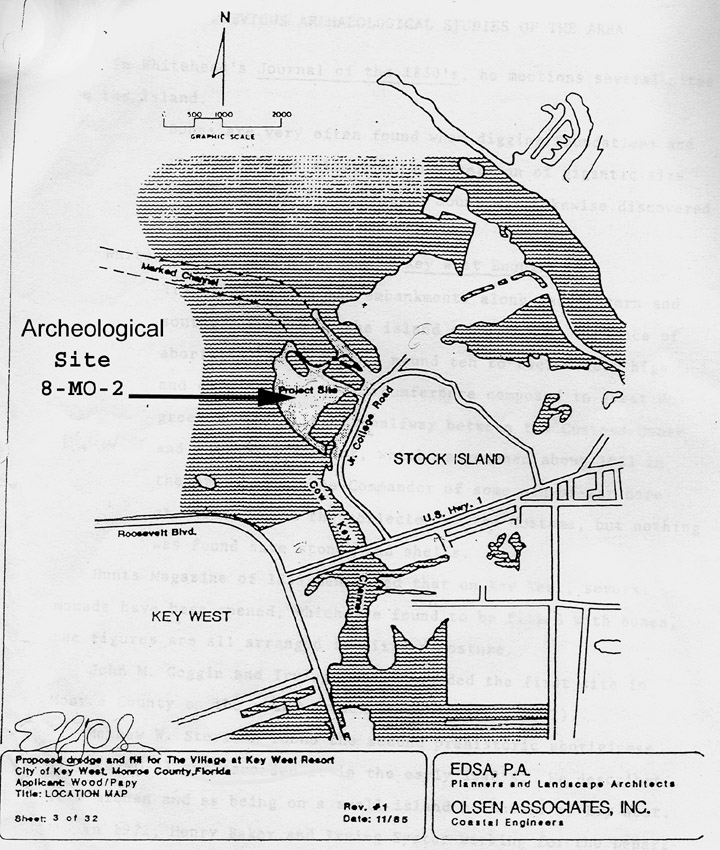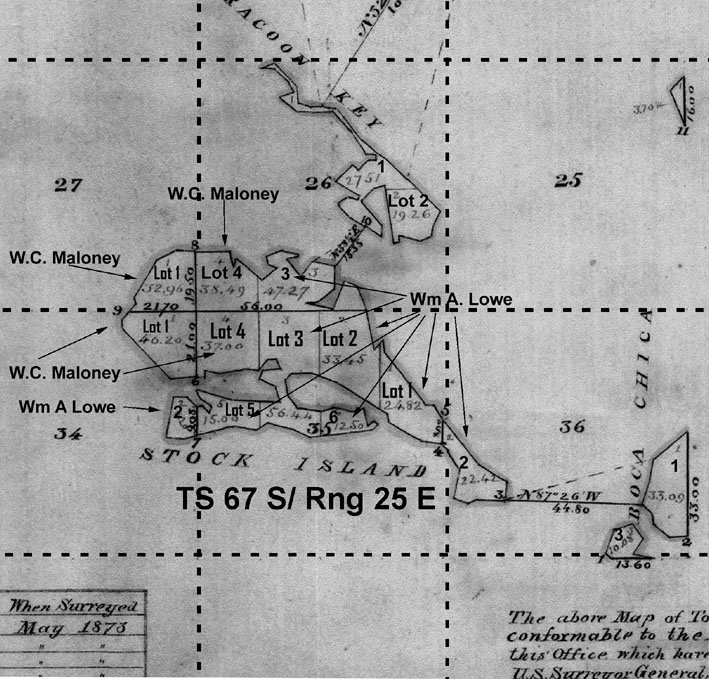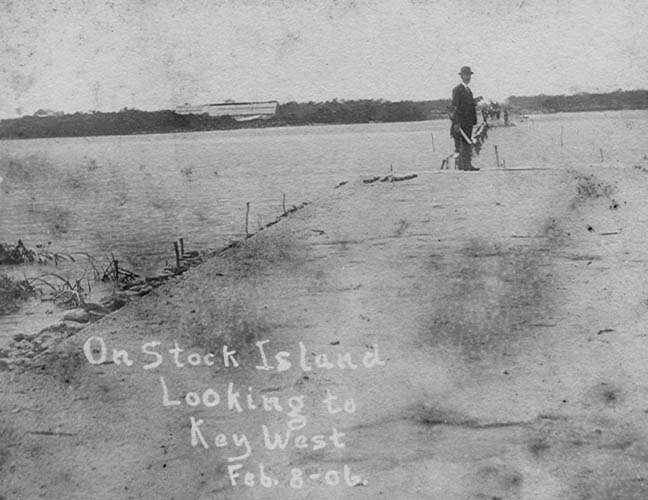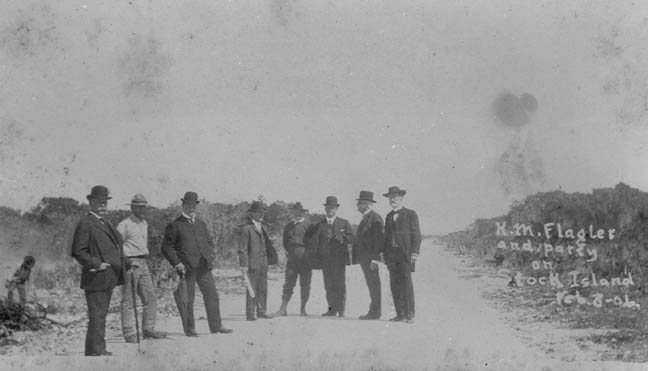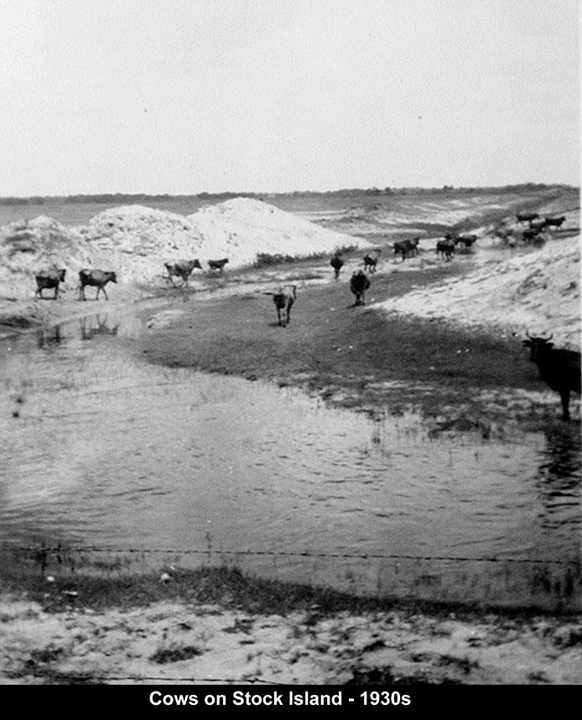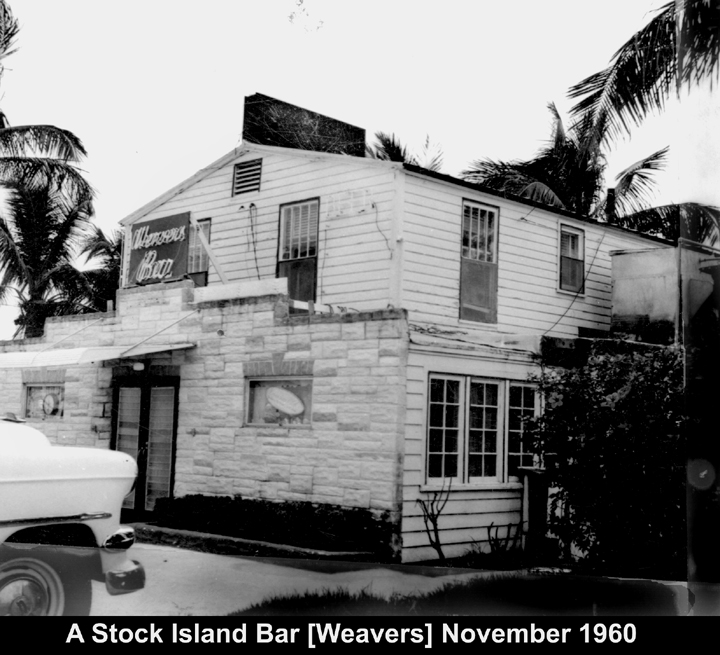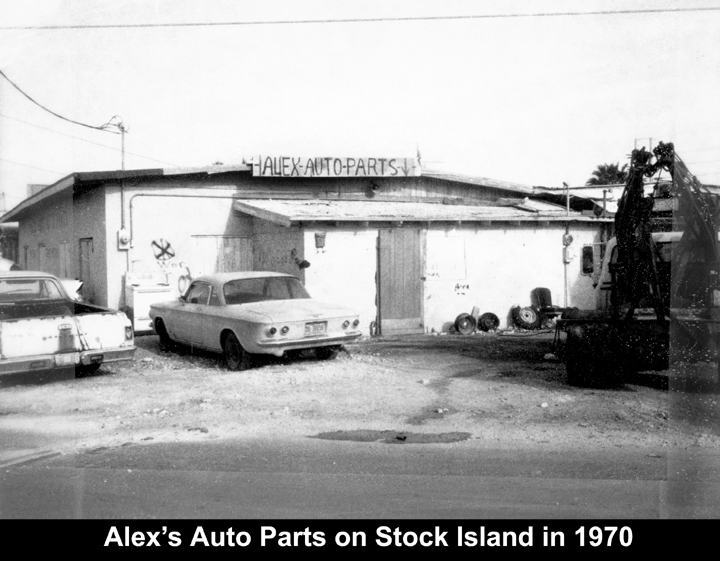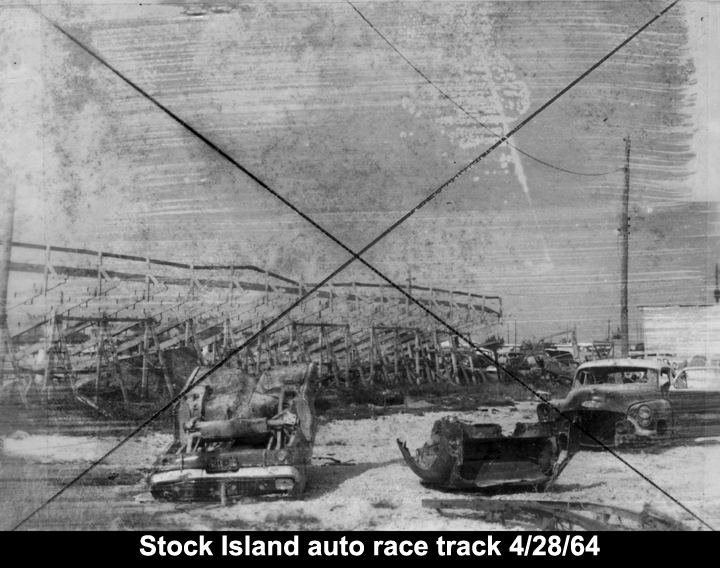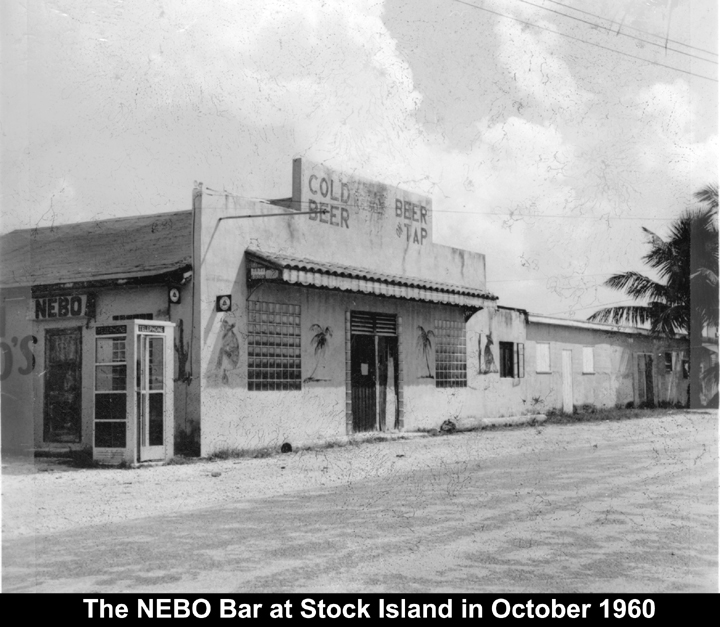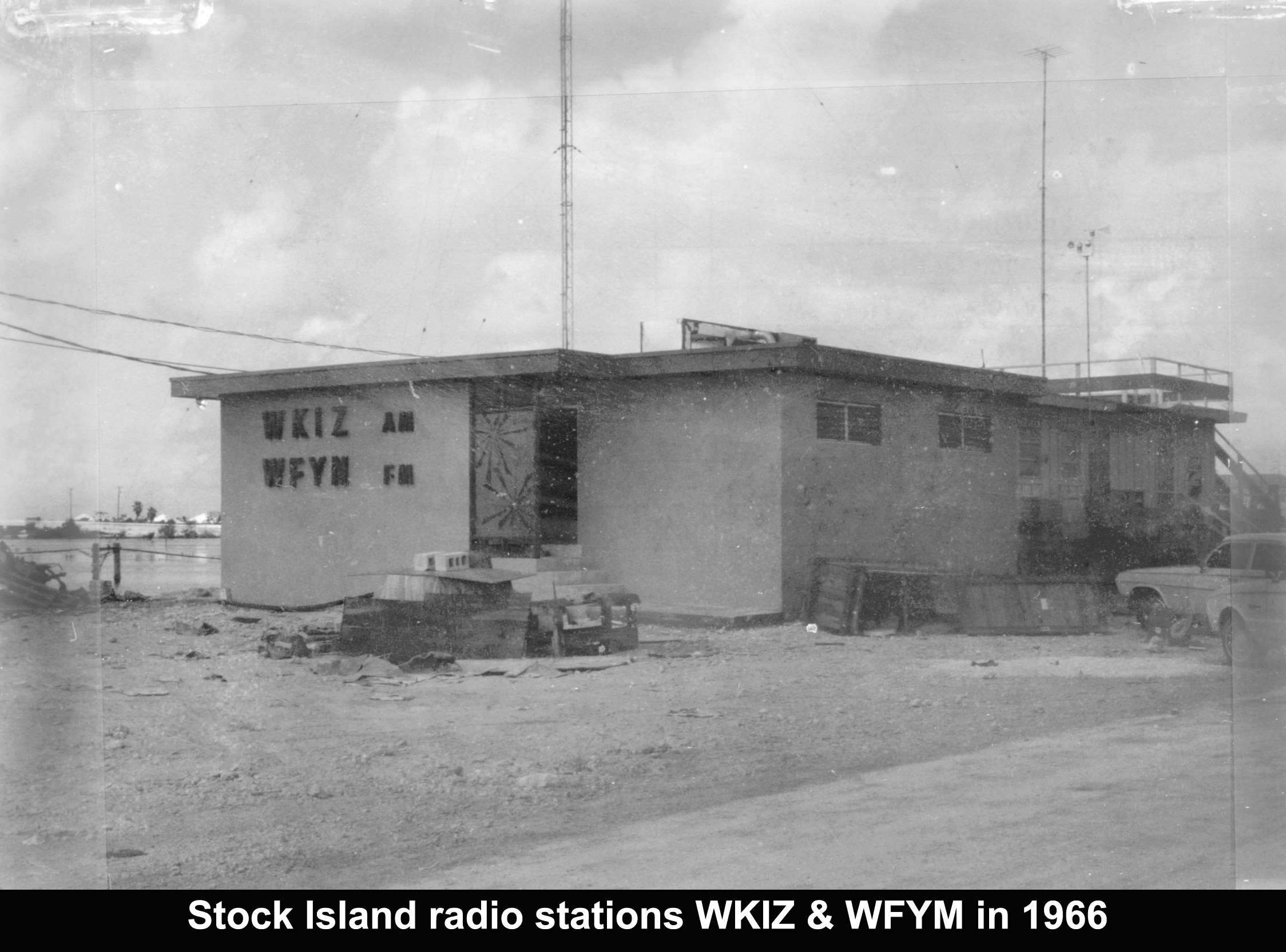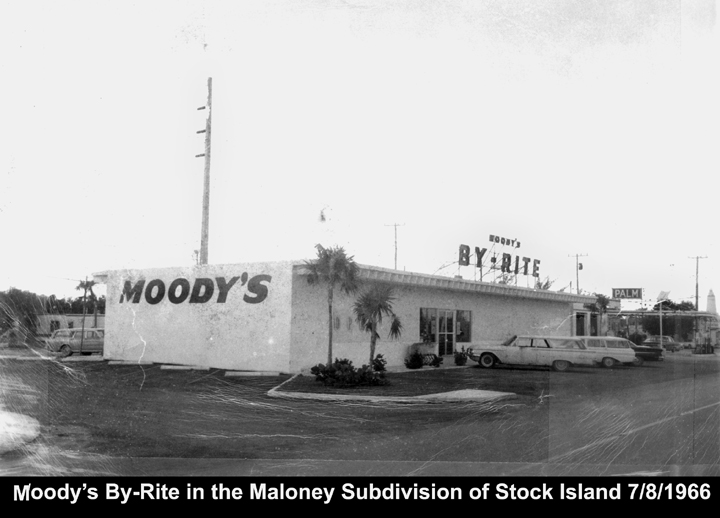History of Stock Island By Jerry S. Wilkinson
Like the other Florida Keys, Stock Island began as a knob of coral rock that appeared as the ocean waters dropped millenniums ago. Getting a specifically designated name took much longer than its neighbor to the west, Cayo Hueso. Also similar to some of the other Keys, the origin of its name is troublesome. The Spanish gave names to some of the Keys, especially after the wreck of the fleet in 1733. When written records do not associate a Key with a historical event, I search for the oldest chart/map that does name it. The above nautical chart is dated "1850" and is one of the Coastal survey series. President Thomas Jefferson created the United States Coastal Survey (USCS) in 1807 but the forthcoming war delayed it getting down to business. I have a feeling that Stock Island is on the USCS first charts of the Key in 1840, but I don't have a copy of that chart far enough south to see whether Stock Island is named. I am certain there are interesting tales of how Stock Island got its name, but it is clear that by 1850 the name was in use. 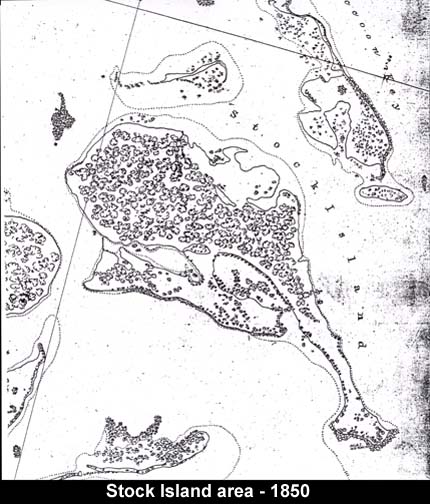
The legend of 'stock' such as cattle, horses, donkeys, etc. could be true, but is it the same as for the Spanish having cows on Key Vaca - a legend. The Spanish carried considerable "stock" on their voyages and I believe it was they that introduced the horse to North America. There were inhabitants of Key West that could have assisted the USCS surveyors and passed the name on to them, or it could have been a person's name. Moser Channel near Marathon was named after a Lt. Moser who was one of the marine surveyors.
If Key West is the name derived from Cayo Hueso, Key of Bones, and these bones were the victims of slaughters by the Native Americans, logic would imply that there would be archaeological sites on Stock Island. In William Whitehead's Journal of the 1830's mentioned when digging foundation sites in 1826-27 in the Key W est area an Indian mound with almost an entire skeleton of gigantic size was found. He continues that an Indian mound was found in 1826 containing many bones. OK, enough for Key West.
From an Archaeological and Historical site survey of proposed Village of Key West Resort for Norman Wood and Bernie C. Papy, March 1973, report reveals "Mathew W. Sterling found the second prehistoric aborigines site (8 -MO-2) and recorded it in the early 1940's. He describes ia a midden and as being on a small Island northeast of Key West." I believe that site 8-MO-2 is located on the Gulf side of Stock Island which I believe is now the jail site. See map at the right. State archaeologist Henry Baker took 22 boxes of artifacts to Tallahassee for cataloging.
The site had been previously disturbed and vandalizing occurred e even while the excavation was in progress. I have never seen any definite interpretation of the time period; however, the report states the pottery was of the Glades Period which would be from 750 b.c. to a.d. 1500 and appeared to be of the Calusas from the west coast od Florida.
In Florida land cannot be officially owned (deeded) until after it can be identified by an official state survey. The image to the right is a hybrid chart that I overlaid the property owners from volume 21 of the Florida Tract Books onto the survey chart by Charles F. Smith 1873. These were the first official owners of Stock Island. How does the amount of land area compare with today's Stock Island?
The entire original survey chart includes all 36 sections of Township 67 South and Range 25 East. Shown here are only sections 25, 26, 27, 34, 35 and 36. Each section is one square mile in size which contains 1,562 acres. As a reference, at the lower right is the western tip of Boca Chica Key. The tiny island at the upper right is labeled as "Monday Key." This particular survey shows the original lots with their numbers which were so faded that I overlaid the numbers in bold type. Each section has its own set of lot numbers beginning with "1." The lot size is shown with their division lines and almost too faded to read is the number of acres which hopefully can be read by enlarging the image. For example, William Lowe's lot 3 of Section 26 had 47.27 acres.
The track book gives the legal information of the original owners including the person's name, date of receipt, date of the deed and where recorded for all 36 sections. The earliest deeded landowner was William A. Lowe dated April 30, 1883 and he owned 8 lots. The other land owner was Walter C. Maloney, who owned five lots with deeds dated June 9, 1893. Therefore, Stock Island began property ownership with two people owning the entire island.
If one has a complete Abstract of Title, he/she should be able to trace ownership back to one of these two owners.
The next piece of documentation that I have of Stock Island is of William J. Krome surveying and reporting to engineer James Meredith of the Key West Extension route for the Florida East Coast Railway owned by Henry M. Flagler. A copy was given to the Key West Library.
In Krome's reports to the chief engineer while surveying the Lower Keys, on March 23, 1905, he wrote "... Stock Islandis west of Boca Chica and separated by Boca Chica Channel. The northern 2/3 of this key is high rocky hammock with a maximum elevation of over 8 feet at mean tide. Almost 1/4 of a mile from the north side of the key, a creek snakes nearly across parallel with the southern shore line. The strip between this creek is low and the rock is near the surface. There are in dwellings or springs on the key. Stock Island offers considerable opportunity for development in case of increasing population in Key West...." Further in the report when writing about Key West Island, he writes, "... On the east it is separated from Stock Island by a channel 1000' wide and less than 2' in depth...." Still further when addressing Boca Chica Channel he wrote, "... It is obstructed by banks but is continually used by boats drawing 3' or less wishing to avoid the rough water in the harbor at the west end of Key West. A strong tidal current passes through this channel...." I understand the creek is still there.
From a group of 1905 to 1906 newspaper clipping collected by Krome and compiled by me and also in the Key West Library, is a clipping titled " Grading At Key West" and dated February 6, 1906, we read,
".... The grade on Stock Island has been completed, and like that of Key West it is built on solid rock. There has been very little filling necessary on Stock Island, in fact for a long stretch in the center of the island, it was necessary to excavate in order to get the required grade.
"To those who has never been over that island a trip over the grade will be a revelation. The soil of the island is exceedingly rich and is admirably fitted for truck farming. There are hundreds of acres of rich hammock land covered with a black loam which will grow anything...."
To the right are two photos taken two days later. At the top of the first photo is a body of water known today as Cow Key Channel. It is difficult to see, but note that there is just a walking bridge in the center of the fill and there are several buildings on the Key West side. Following some text is the second photo of Henry Flagler and a party of friends visiting Stock Island. Flagler is the second from the right.
Another clipping titled "Big Hotel" and dated February 13, 1906, reads "A party of distinguished guests arrived in Key West Wednesday evening by the steamer Shinnecock from MIami.... The party took a ride in a carriage on the county road to the eastern end of the island and to Stock Island across from Key West...."
Continuing to the 1907 clipping book we find a clipping from the Miami Metropolis newspaper (owned by Henry Flagler) dated February 4, 1907, "The Lady Lou carried two portable houses to Stock Island Friday. These houses will be used as the commissary for the camp. A space of 500x600 feet is being cleared away to pitch tents. Mr. Josh, who has been working with the engineer corps in the harbor, has been made resident engineer of Camp 83 at Cuddles. He left today to take charge of the camp. Mr. Colton who has been in charge of Camp 83, will be transferred to Stock Island temporarily."
Now appears a clipping with an amazing declaration if true. A clipping titled "THE NEW TOWN IS NAMED FLAGLER" and dated May 21, 1907, reads, "The title to a valuable tract of land on Stock Island has passed from Mrs. Euphemia Maloney to the promoters of the Florida Keys Land Company.
"As soon as the survey is made and the lines given, several acres of land will be put on the market and an effort will be made to develop it at once.
"The town to be located there has already been named Flagler, after Florida's great benefactor. The plans of the company will be made public in a few days. -- Key West Citizen"
The above is the only documented mention that I have found of a town named Flagler, or any town on Stock Island. It could have just been rumor or hype, or the concept died as in July 1907 the U.S. Navy through the War Department stopped the dredging and filling for Flagler's additional 135 acres for the Key West Terminal. If the railroad was not going to be built, then the idea of a town may not be such a good investment.
There is more to the story of the Navy stopping the construction, but briefly, Henry Flagler almost immediately stopped all work south of Knight's Key Dock, pulled out his work crews, equipment and closed his Key West offices for the remaining Keys southward of Marathon, and completed building a mini city/terminal about a mile and a half out in Moser Channel south of Marathon. Many say that this was his way of saying, 'for those who want the railroad built to Key West - resolve this problem.' He operated all of 1908 from Knight's Key Dock until the Navy yielded to the dredging at Key West, then started the Seven Mile Bridge in 1909. In the meantime, all of the floating construction equipment was brought north and stored in the Miami River.
This could have been a motive to walk away for the proposed new town on Stock Island. Regardless, Flagler appears not to fight the Navy, but simply [my words] let the powers of Key West and Florida take care of the problem. After a year in early 1909 it was resolved, the Navy yielded, Flagler completed the Key West Trumbo Point depot and began the Seven Mile Bridge continuation onward to Key West.
Leading up to two more Stock Island articles, the Key West Citizenpublished on May 11, 1910 the following; "The first spike to be driven on the Key West end of the FEC RR was hammered down at 12:33 (on May 10th) on Trumbo Island. There were no ceremonies. The track which is being built is a short stub from the dock to a point on Trumbo Island and will be used primarily for the handling of material."
On June 27, 1910 the Key West Citizen published: "At 5 o'clock Sunday afternoon, June 26, 1910, with no ceremony and few witnesses, Mr. Ernest Cotton, Prof. M.P. Geiger, Dr. J.B. Maloney, Misses Margaret Jones, Florence and Ottillie, and a few railroad employees, the greatest event occurred on Stock Island that has ever happened - the landing of engine No. 12 of the FEC RR. She had a hard pull to get ashore as the grade was steep and rails slippery, but by the aid of a few shovels of sand and extra steam she landed high and dry. Three blasts of her whistle and she was ready for work."
I assume this is related to the same event, on June 29, 1910, the Miami News-Recordpublished: "Engine No. 12 which is known as the "pioneer" of the Key West Extension arrived at the northern end of Stock Island, about 6 miles from Key West. It had been loaded on a barge towed by the steamer PHIL SHECKEL. The locomotive will be engaged in hauling material for the construction of the track on Stock Island. The engine sent to Stock Island for the purpose of facilitating the track construction on the Key.
"There are nearly 1000 men now employed between Key West and Boat [Boot - JW] Key Harbor. Boca Chica has a gang of about 200 men. Of this number about 70 are engaged in laying rails."
The coming of the railroad to Key West had already improved the access by the average citizen to Stock Island with a foot bridge. I do not have the actual documentation but The meager beginning takes us back to 1917, when Monroe County floated a $100,000 bond issue to build roads, or trails, on Key Largo, Big Pine Key and a bridge from Key West to Stock Island.
These three bridges and the coming of the Florida Land Boom in the 1920s evolved into the beginning of the first Over Seas Highway (OSH) when Monroe County residents voted a $300,000 bond issue in 1922 to construct a road from the Anglers Club near the north end of Key Largo, down the key of Key Largo and along side of the railroad to Matecumbe. Additional roadwork was also to be done in Key West and the Lower Keys. Dade County was to build the road from Homestead to Card Sound.
Stock Island obviously become useful to Key West as in March 1924 the first six holes of the Stock Island opened for play. Some where in the archives must be the details of an amenity such as a recreation activity in the 1920.
In 1926, Monroe County floated a $2.5 million bond issue with an amazing two opposing votes for more road construction. The Hurricane of 1926 caused some damage to the Upper Keys road construction but changes were made and in 1927 it was obvious that a highway at both ends would be built with a water gap of 40 miles between Lower Matecumbe Key and No Name Key.Three ferryboats were ordered from the Gibb's Shipyard of Jacksonville for $850,000 and on January 16, 1928 State Road 4A was opened for two way traffic. The highway crossed Stock Island via today's MacDonald Avenue, Maloney Avenue across a wooden bridge to Boca Chica and followed the ocean side route, then crossing the railroad track on Sugarloaf Key to the Gulf side, then across Bow Channel and on to No Name Key via the 'old wooden bridge', or vice versa. Some remnants of the right-of-way and rotten wooded pilings remain, but only to a very interested investigator. Boaters throughout the Lower Keys occasionally find isolated groups of old bridge pilings.
For certain by 1928, all the Keys between Key West and No Name Key were accessible by automobile and weekend cottages/homes and 'fish camps' became a norm.
Even during the toll road operation of the OSH after the 1935 Hurricane, the toll plaza was located at the eastern end of Big Pine Key. This had to have caused considerable development on Stock Island. I am a little surprised that the 1938 American Guide Series "U.S. One - Maine to Florida,"compiled and written by the Federal Writers Project of the Works Progress Administration (Modern Age Books, Inc. New York, 1938) skips from Boca Chica Key directly to Key West as if Stock Island did not exist. Yet, it mentions a "Botanical Garden." After a few paragraphs of pleading for assistance, I will display some Stock Island photos that I copied from the Florida Room courtesy of the Key West Library from old property record cards, thanks to Tom Hambright.
There were cows once on Stock Island; however, in this photo a little late to give it it's name.
At this early time in Stock Island's history, the author is out of additional comprehensive and documented history to continue. I am of the opinion that Stock Island is too precious just to drop off the radar screen. Who was the first family? How did the volunteer fire department begin? When did Key West annex the northern part? What was the first church and where? Was there ever a school? Were there any political figures? The KWC microfilm at the Key West library has the history there, but I don't have access to it - believe me, it will be neck breaking, eye straining and time consuming task to ferret it off of microfilm.
It is well known that the Monroe General Hospital opened on Stock Island in 1944; therefore, Stock Island must have been reasonably well developed as there was space for a hospital on the eastern part of Key West. Of course World War II was in progress. The largest drive-in theater opened in 1053 and all of these amenities require large land parcels.
The Key West Citizen reported in February 1952 that at Mom's Tea Room on Stock Island, Rita Brown, died of an overdose of a drugs.
According to the Key West Citizen the new dog track opened with 4,000 attending in January 1953.
Realizing that had we began a couple decades earlier we could have collected more and better information, but that is true with all the Keys. I believe that it is true that Monroe County's shorted lived city was the City of Stock Island. There is a story that freeholders approved incorporation in July 1963 only to have Circuit Judge Aquilino Lopez Jr. overturn the election effective March 26, 1964. What I do find in Monroe County election records is a certified freeholders election dated July 22, 1964 for "An act creating and chartering a muncipality to be known as the City of Stock Island, in Monroe County, Florida, and to define its territorial boundaries ...." There were 83 votes cast of whicn 36 voted for the incorporation and 47 voted against.
From the KWC the other week I saw that on "On January 31, 1953 the dog track, which was built in six weeks, opened with about 4,000 attending." There must be more to this history.
Whether we agree that it is a part of history or not, I have bits of info that before WW-II Rose Rabin had a bawdy place on Truman Ave. in Key West and the Navy forced her to move to Stock Island. Later, the local Navy met with the Secretary of Navy that they would move the base away if Key West did no clean up the illegal operations - prostitutes and B-Girls. In 1954 she was closed. In 1955 she applied to open again in Key West and Key West revoked her license for the Imperial Club on Whitehurst. Is there documentation?
-Miscellaneous Stock Island Photos with questionable captions -
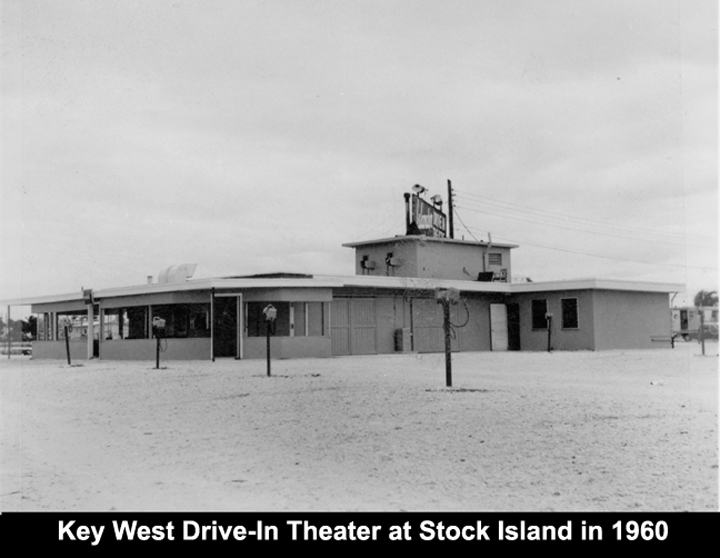
When the "Islander" first opened on Stock Island in February 1953, it had the largest screen in the state of Florida. It had parking for 600 cars and opened with "The Cimarron Kid" starring Audie Murphy and Yvette Dugay.
Use Back Arrow to return to reading previous page or:
To return to the Specific Locations and Keys homepage, Click HERE.
